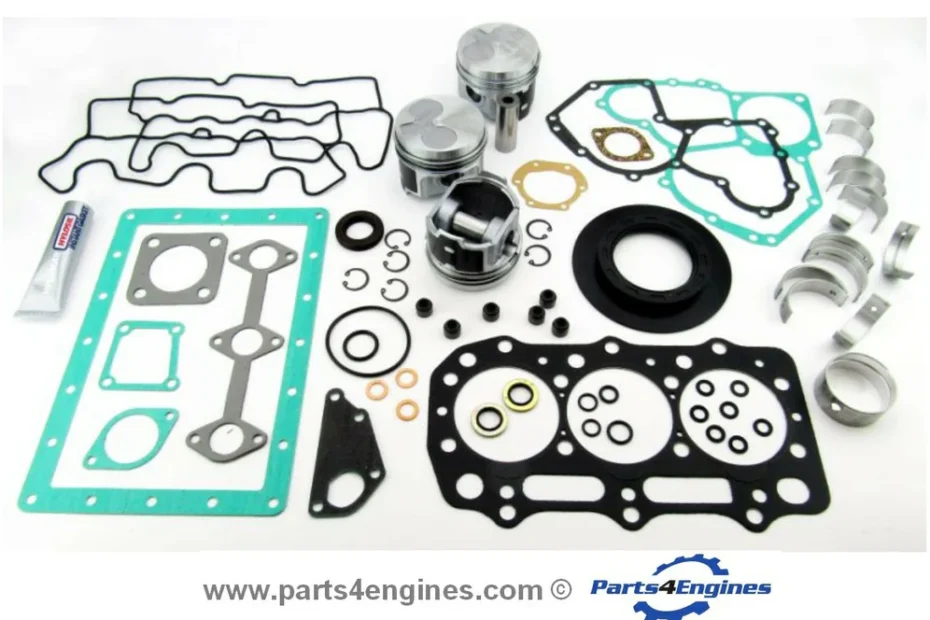Introduction
Have you ever wondered whether rebuilding your marine diesel engine could really bring it back to life? We decided to find out firsthand by rebuilding ours using a popular engine rebuild kit. Here’s exactly what we discovered.
Why Choose an Engine Rebuild?
Let’s face it, marine diesel engines take a beating. Saltwater, constant operation, and harsh environments mean wear and tear is inevitable. Instead of replacing the whole engine (which can cost a fortune), rebuilding offers a smart, budget-friendly alternative.
Introducing the Marine Diesel Engine Rebuild Kit
What’s Included in the Kit?
The kit we chose included everything from pistons and rings to gaskets, bearings, seals, and valves. Basically, every essential part you’d need to restore your engine’s performance.
Here is the list of parts it includes:
- Pistons x 3
- Gudgeon pins x 3
- Gudgeon pin circlips x 6
- Piston ring sets x 3
- Big end bearing set x 1
- Main bearing set x 1
- Main bearing bush x 1
- Complete gasket set – includes valve seals and injector copper washers
- Front and rear crankshaft oil seals
- Tube of quality gasket sealant
- Bottle of Lucas Oils assembly lube
Quality of Components
We were genuinely impressed by the quality of the kit. Each component felt robust, durable, and built to withstand marine conditions.
if you would like to buy this kit, please click here for the rebuild kit
Preparing for the Engine Rebuild
Assessing Engine Condition
Before diving in, we thoroughly inspected our engine. Checking for signs of major damage or severe corrosion helped us plan our rebuild effectively.
Tools and Workspace Setup
Proper organisation is key. We made sure our workspace was clean, spacious, and had all necessary tools within easy reach.
Step-by-Step: How We Rebuilt Our Marine Diesel Engine
Engine Disassembly
We started by carefully removing external components and gradually disassembling the engine, taking photos along the way to remember part placement.
Inspecting Engine Components
Each component was checked meticulously. We looked for any issues like cracks, wear, or corrosion that might have been missed earlier.
Cleaning and Preparation
Cleaning each part thoroughly was crucial. We used specialised cleaners and ensured all surfaces were free of contaminants before reassembly.
Installing the New Parts
Installing parts from the rebuild kit was straightforward. Components fit perfectly, a sign of excellent kit quality.
Reassembling the Engine
With everything installed, we carefully put the engine back together. Taking our time ensured accuracy and reduced risks of mistakes.
Challenges We Encountered During the Rebuild
Unexpected Issues
Not everything went perfectly. We hit a snag when we discovered additional wear on the crankshaft, requiring extra machining work.
Finding Replacement Parts
Sourcing additional replacement parts caused a slight delay, but luckily the kit’s supplier provided excellent support.
First Start-Up: Moment of Truth
Initial Observations
When we fired the engine up for the first time, it was nerve-wracking. Thankfully, it started smoothly, with no alarming noises or leaks.
Performance Check
We took it out on the water and immediately noticed improvements. It felt like we had a brand-new engine.
Performance Review: Before vs After the Rebuild
Fuel Efficiency
Fuel consumption noticeably improved. Our rebuilt engine was running cleaner and using significantly less fuel.
Noise Levels
Noise levels reduced dramatically, creating a more pleasant boating experience.
Power and Acceleration
The engine responded quicker and had greater power output, accelerating our boat effortlessly.
Reliability and Maintenance Improvements
Post-rebuild, our maintenance needs dropped sharply. Fewer breakdowns meant more confidence on the water, which is priceless.
Cost Comparison: Rebuild vs Replacement
The rebuild cost us less than half of what a new engine would. The savings were substantial, making it a sensible financial choice.
Environmental Benefits of Rebuilding
Rebuilding reduced our environmental footprint dramatically. By reusing the existing block and many components, we avoided contributing to landfill waste and conserved resources.
Who Should Consider a Rebuild Kit?
If you have an older engine still in decent condition, a rebuild kit is ideal. It’s perfect if you’re mechanically inclined or have access to professional assistance.
Expert Tips for a Successful Engine Rebuild
- Always document the disassembly process.
- Inspect and clean meticulously.
- Don’t rush the reassembly phase.
- Replace additional worn parts when needed.
Common Mistakes to Avoid
- Skipping thorough inspections.
- Using cheap, inferior rebuild kits.
- Not following torque specifications.
- Ignoring minor wear, which can cause bigger problems later.
Final Thoughts: Was the Kit Worth It?
Absolutely! Our rebuilt marine diesel engine runs smoother, quieter, and more efficiently. The kit delivered beyond our expectations, making it a fantastic investment.
Conclusion
Rebuilding a marine diesel engine using a quality kit proved highly beneficial for us. It not only saved money but also delivered outstanding performance improvements. If you’re considering rebuilding your engine, we highly recommend it—it might be exactly what your boat needs.
